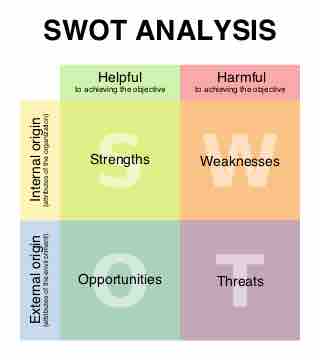In business and engineering, new product development (NPD) is the complete process of bringing a new product to market. A product is a set of benefits offered for exchange. It can be tangible (something physical you can touch) or intangible (like a service, experience, or belief). There are two parallel paths involved in the NPD process: idea generation, including product design and detail engineering; and market research and marketing analysis. Companies typically see new product development as the first stage in generating and commercializing a new product within the overall strategic process of product life cycle management, used to maintain or grow their market share.
Ideas for new products can be obtained from basic research using SWOT analysis: Strengths, Weaknesses, Opportunities & Threats. Many methods may be used to gain insight into new product lines or product features, including:

SWOT Analysis
Here is an example of the SWOT analysis matrix.
- Market and consumer trends
- Research and development
- Competitors
- Focus groups and trade shows
- Employees and corporate spies
- Salespeople
- Ethnographic discovery methods (searching for user patterns and habits)
Five Different Front-End Elements
- Opportunity identification: Large or incremental business and technological chances are identified in a relatively structured way. Using the guidelines established here, resources are allocated to new projects, leading to a structured New Product & Process Development or NPPD strategy.
- Opportunity analysis: This element translates identified opportunities into implications for the business and technology specific context of the company. This element focuses on aligning ideas to target customer groups, and can include market studies and/or technical trials and research.
- Idea genesis: The evolutionary and iterative process of progressing an initial idea from birth to maturation into a tangible idea. This process can occur internally or externally (e.g., a supplier offering a new material or technology, or a customer presenting an unusual request.
- Idea selection: The decision to pursue an idea is determined by analyzing its potential business value.
- Concept and technology development: During this part of the front-end, the business case is developed based on estimates of the total available market, customer needs, investment requirements, competition analysis and project uncertainty. Some organizations consider this the first stage of the NPPD process